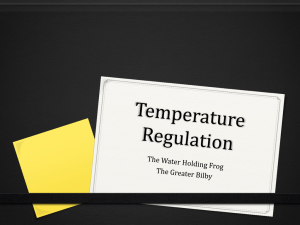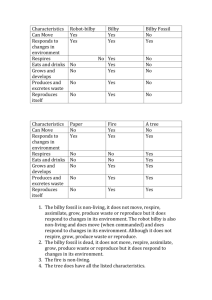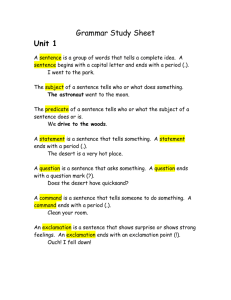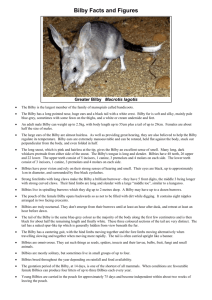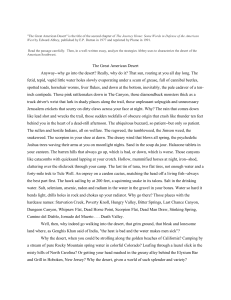Bilby Moon Teachers
advertisement
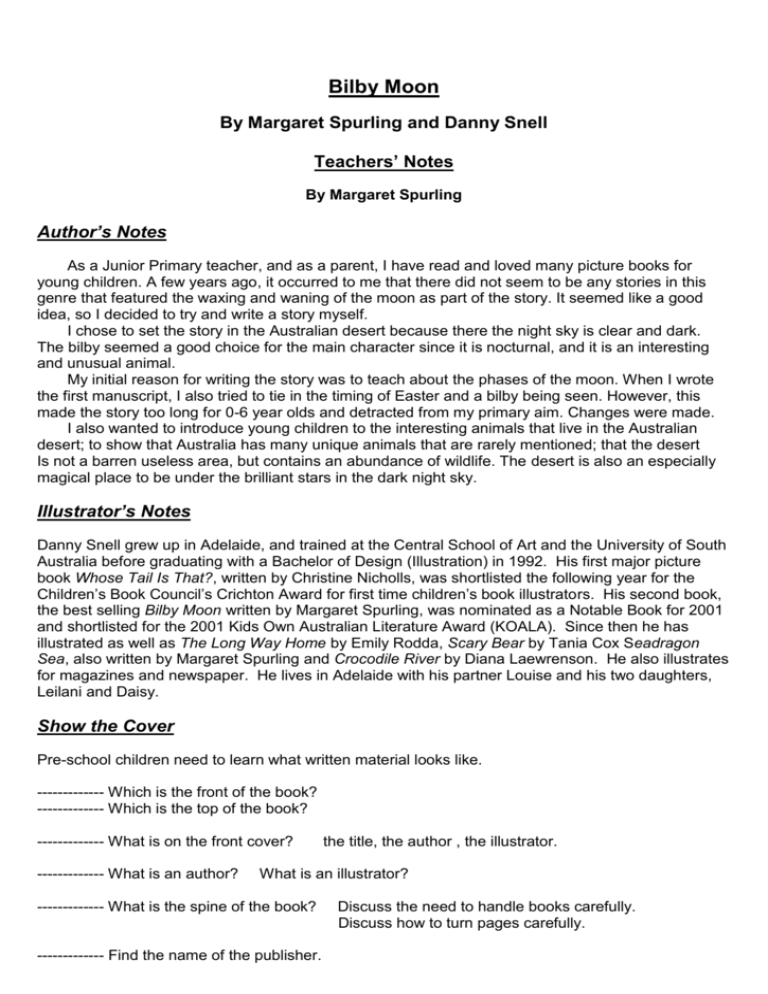
Bilby Moon By Margaret Spurling and Danny Snell Teachers’ Notes By Margaret Spurling Author’s Notes As a Junior Primary teacher, and as a parent, I have read and loved many picture books for young children. A few years ago, it occurred to me that there did not seem to be any stories in this genre that featured the waxing and waning of the moon as part of the story. It seemed like a good idea, so I decided to try and write a story myself. I chose to set the story in the Australian desert because there the night sky is clear and dark. The bilby seemed a good choice for the main character since it is nocturnal, and it is an interesting and unusual animal. My initial reason for writing the story was to teach about the phases of the moon. When I wrote the first manuscript, I also tried to tie in the timing of Easter and a bilby being seen. However, this made the story too long for 0-6 year olds and detracted from my primary aim. Changes were made. I also wanted to introduce young children to the interesting animals that live in the Australian desert; to show that Australia has many unique animals that are rarely mentioned; that the desert Is not a barren useless area, but contains an abundance of wildlife. The desert is also an especially magical place to be under the brilliant stars in the dark night sky. Illustrator’s Notes Danny Snell grew up in Adelaide, and trained at the Central School of Art and the University of South Australia before graduating with a Bachelor of Design (Illustration) in 1992. His first major picture book Whose Tail Is That?, written by Christine Nicholls, was shortlisted the following year for the Children’s Book Council’s Crichton Award for first time children’s book illustrators. His second book, the best selling Bilby Moon written by Margaret Spurling, was nominated as a Notable Book for 2001 and shortlisted for the 2001 Kids Own Australian Literature Award (KOALA). Since then he has illustrated as well as The Long Way Home by Emily Rodda, Scary Bear by Tania Cox Seadragon Sea, also written by Margaret Spurling and Crocodile River by Diana Laewrenson. He also illustrates for magazines and newspaper. He lives in Adelaide with his partner Louise and his two daughters, Leilani and Daisy. Show the Cover Pre-school children need to learn what written material looks like. ------------- Which is the front of the book? ------------- Which is the top of the book? ------------- What is on the front cover? ------------- What is an author? the title, the author , the illustrator. What is an illustrator? ------------- What is the spine of the book? ------------- Find the name of the publisher. Discuss the need to handle books carefully. Discuss how to turn pages carefully. ------------- Look at the picture on the cover. What do you think the story might be about? ------------- What is a bilby? Where would you find a bilby? Comprehension after initial reading Which is the main character in the story? Where is the story set? Why does Little Bilby like the moon? Why does Little Bilby become worried? Who helps Little Bilby? Why do you think Little Bilby hasn’t learnt about the moon yet? Who explains the mystery of the moon to Little Bilby? Do you think Lilttle Bilby will worry about the moon anymore? Critical Thinking Do the animals in the story really live in the desert? What are the real aspects of the story? Discuss the imaginary elements of the story. Does the moon really disappear? Look at the illustrations. What do you notice about the crescent moons? What is the different about the crescent moons in different parts of the cycle of the moon? Phonics Activities Initial Sounds Teach the initial sounds of all the animals in the story. ------eg. “b” List all the animals you can think of that start with “b”. Make a “b’ with plasticene. Make a stencil . Colour only the things that start with “b”. Vowels Discuss vowels and the use of “a” and “an”. --------ie. a bilby, an echidna, a mole, a froglet, a boobook owl, an owl, an ant. Reading Activities Recognition of animals. Match words to pictures. Visual discrimination – complete the picture (what is missing?---- the tail) Unjumble words. Unjumble sentences. Play Concentration. Words from the story are written twice on cards. Children take turns and match words. Person with the most cards wins. Pg.3 Bilby Billboard - on which children can place interesting words that they have learnt about the animals and their habitat. Three Clues for the Detective - guess which character in the story with the help of three clues given for each one. Eg. Red ----- sleepy ----- wily. Sense & Nonsense - children choose the proper ending and write the whole sentence. Eg. Little Bilby - sang a song. - twitched her nose. Creative Writing Create a big book about another desert animal. Interview Little Bilby. Write your own story about the moon and an animal of your choice. Write a letter to a friend about your holiday trip in the desert. If I were a bilby. Write a story that uses the changing light of the moon. Maths Activities Number ------ count the animals in the story. ------ make a join-the dots stencil of each desert animal. Shapes Circles ----- make a picture of the full moon. ----- make a mobile of the boobook owl using cardboard strips. Use a large circle for the body, smaller circles for the eyes. Cut out ears and fringe, then glue to the top of the body. Sequences &Sets Collect many kinds of stones. Sort into groups of the same kind. (size,colour, texture,etc.). Make pattern sequences with the stones. Drama Retell and act out the story. Use paper plate face masks. Movement ----- Make the tracks of the different desert animals in soft sand. Move like the animals move. Art Make paper plate face masks of the animals in the story. Pop stick puppets. Felt cut outs of the animals. Stick to felt board and tell the story. Make a moon mobile, showing the phases of the moon. Make a mobile that depicts the story. Draw an echidna, or make a stencil of an echidna. ---- paint or colour the echidna. ---- glue short twigs to the stencil to give a spiky texture, or glue fringes of brown paper to give a spiky effect. ---- display the echidnas among ant hills. Make other such stencils for the other animals. Make papier mache animals. Make a collage of a desert scene, using natural materials eg. Bark, sand, twigs etc. Make a bookmark. Cut one corner from a discarded envelope to make a functional bookmark which slips over the upper corner of the book page. These markers can be decorated by gluing a cut paper shape (of a bilby etc.) over the point of the corner so that the decoration projects beyond the edge of the book. Society and Environment Co-operation ----- helping each other ----- being a friend; listening to others’ concerns ----- concern for others less able ie. telling mole, who cannot see, about the moon. The Easter Bilby The idea of the Easter Bilby came about as a way to raise money to help restore the environment to allow native animals to have a chance of re-establishing. The main causes of the decline of our native wildlife have been the rabbit, the fox, the cat and land clearance generally. Once, 200 million bilbies roamed over 70 per cent of Australia. Now, less than 2000 are concentrated in south-west Queensland, central Australia and bordering the Kimberly region of Western Australia. Easter is a Christian festival to celebrate New Life, and traditionally in the Western world, the rabbit (the Easter Bunny) has brought children Easter eggs, a symbol of New Life. The origin of the Easter Bunny may be related to a German legend, which tells of a poor woman who, during a famine, dyed eggs and hid them in a nest as Easter gifts for her children. As the children discovered the eggs, a rabbit hopped away. The relationship between Easter and the rabbit may also derive from the ancient world, where rabbits, or hares, symbolised fertility and new life and were associated with Spring festivals. Therefore, early Christians may have adopted the rabbit as a symbol of Christ’s resurrection. In some cultures, the rabbit is associated with the moon, which determines the date of Easter each year. Easter Sunday is the first Sunday after the first full moon after the March equinox. However, not all Christians celebrate it on the same day. The Orthodox church celebrates Easter a month later. In Australia, the rabbit is regarded as a pest, and many people feel that the Easter Bunny could be replaced by the Easter Bilby. Chocolate bilbies are available at Easter time from a number of chocolate manufacturers and most donate part of the proceeds to various endangered species funds. However, the copyright to the term “Easter Bilby” is owned by the Anti Rabbit Foundation of Australia. Royalties are to be paid by any company that uses the words “Easter Bilby” in their marketing, and funds raised from the sale of Easter Bilbies are used to conserve a range of endangered species. Habitat --- the central desert region of Australia The main character in the story, Little Bilby, meets other animals that also live in the central desert region of Australia. All these animals have distribution areas that overlap. The animals used in the story are based on the Greater Bilby (Macrotis lagotis), the Spinifex Hopping-mouse (Notomys alexis), the Military Sand-dragon (Ctenophorus isolepis), the Short-beaked Echidna (Tachyglossus aculeatus), the Marsupial Mole (Notoryctes typhlops), the Chirping Froglet (Crinia deserticola) and the Boobook Owl (Ninox boobook). The Greater Bilby is a marsupial, and is the largest member of the bandicoot family. It is the only bandicoot to construct a burrow (up to 1.8 metres deep), where it shelters from the heat of the desert by day, and emerges at night to forage for food. It inhabits desert grasslands and shrublands with spinifex or tussock grass. It is an endangered species. The Lesser Bilby may already be extinct. It was last reported alive in 1931. The Spinifex Hopping-mouse is a native desert rodent that inhabits stabilised sandhills and loamy areas where mulga trees grow. It can survive without drinking water. It burrows up to one metre deep, and at dusk it emerges to be active most of the night. The Military Sand-dragon is a lizard that lives on sand plains and interdunal flats with prickly porcupine grass (Triodia), in which it shelters from the sun and predators. The Military Sand-dragon is so named because its reddish colour was reminiscent of early military uniforms. Its colour makes it almost invisible against the reddish sands of its natural environment. It feeds maimly on ants, but termites and other insects are eaten. At night it shelters in a Triodia hummock and also avoids the extreme heat of a summer day by resting in the deep interior of such a hummock. The Short-beaked Echidna is a monotreme, a mammal that lays eggs and suckles its young. It occurs in almost all Australian habitats, including the desert. Its requirement is a supply of ants and termites on which it feeds. In the desert it shelters under thick bushes by day, and is active at night. The Marsupial Mole inhabits sand dunes, interdunal flats and sandy soils along river flats. It is blind and spends most of its life underground, but occasionally comes to the surface, especially after rain. It often burrows horizontally, about 10-20 centimetres below the surface. The pouch of the female is backwardly opening and little is known of its reproduction. The Chirping Froglet is a desert froglet. At night, when dew begins to fall, it forages along the ground in the moistened undergrowth. It hunts for small arthropods, ants forming the major part of the diet. It is inactive during the day, when it shelters under leaves. It does not depend on rain to breed. Mating usually takes place along the permanent waterholes of drying rivers and creeks. When rains come, the desert is alive with the chirping of these frogs. The Boobook Owl is the smallest and most abundant of the Australian owls. It is distributed Australiawide and lives in all habitats, from forests to deserts. However, it is not often seen. Its presence is evident by its characteristic call “mo-poke”, which carries for a kilometre or more. During the day it roosts in a tree-hole or cave, or sometimes on a branch with dense foliage. It hunts for food on the wing at night, and its diet consists mainly of moths and night-flying beetles. It sometimes swoops to the ground to seize small mammals such as mice. Find wildlife books to discover more about these animals. PUse these headings. ------ Common Name ------ Features (eg. Soft silky fur) ------ Scientific Name ------ Distribution ------ Related Species ------ Habitat ------ Conservation Status ------ Ecology ------ Size ------ Threats Other wildlife found in the central desert region. Mammals – kangaroo, kowari, ningaui, dunnart, hopping mice, the plains rat, mulgara. Reptiles – goanna, thorny devil, legless skink, sand-dragons, bearded dragons, gecko, Children’s python, bandy bandy snake, womma python. Birds – gibber bird, barn owl, spinifexbird, kite, hawk, princess parrot. Amphibians – the burrowing frog. Insects – fire beetle, grasshopper, hunting spiders, termites, ants, honey ants. Type of Vegetation Spinifex and porcupine grasslands; mulga and acacia shrublands. Activities Discuss what happens in the desert when it rains. Find out which other animals of the desert are endangered: the plains rat, the dusky hopping mouse, the sandhill dunnart, the bronzeback legless lizard, the pernatty knobtail, the princess parrot. Under threat of becoming endangered ----- rock dragon, mulgara. Discuss the illegal trade of some of our native wildlife. Reptiles and birds have been targeted. What is the role of the National Parks and Wildlife Service? Make a school trip to the local zoo or museum to discover more about Australian desert fauna and flora. Choose one aspect of the desert that interests you for a project. Discuss why we should prevent species from becoming extinct. Did you know? The bilby does not lie down to sleep. Instead, it squats back on its hind legs tucking its muzzle between its forelegs. The long ears are folded forward over its eyes. Science Activities Make an ant farm. Watch the behaviour of an ant colony. Materials: 2 clear glass jars, one slightly smaller than the other; loose or sandy soil, sugar, water. The idea is to make the ants’ living area a very narrow place, which can be seen from the sides. Put the smaller jar, without the lid, upside down into the centre of the larger jar. The space between the two jars should be filled with loose or sandy soil. Be sure the space is completely filled, but do not pack the soil too tightly, or the ants may find it too hard to dig. Find some ants. To make an ant trap, mix a little sugar with a little water in a small jar or can. Put the can down on its side on the ground. The ants will go in looking for the sugar food. It is very important that all the ants put in the ant jar are from the same colony. Ants from different colonies will probably fight and kill each other. Put the ants you have collected into the ant jar, and screw on the lid to keep them from escaping. Do not worry about the ants getting enough air. When you remove the lid for feeding, plenty of fresh air will enter. Do not crowd too many ants in the ant jar. The fewer the ants the more activity there will be. In about a day the ants will begin to build tunnels and rooms. Once a week only, feed the ants a few drops of sugar water, and a few grains of bird or grass seed. Put the food directly on the soil. It is tempting, but do not overfeed the ants or they may die. Keep the ant jar at normal room temperature and away from radiators, air conditioners and direct sunlight. If you do not disturb the ant jar, the ants will build a complete underground city. Observe the phases of the moon. Cut out from the weather page of the daily newspaper, the daily times that the moon rises and sets. Observe each night. A full cycle is 28 days. What is the waxing and waning of the moon? Discuss the optical illusion of the moon. It appears to be very large as it rises above the horizon. Why do astronomers go to isolated places such as the centre of Australia to observe the stars in the night sky? What is the effect of light pollution in the city?
